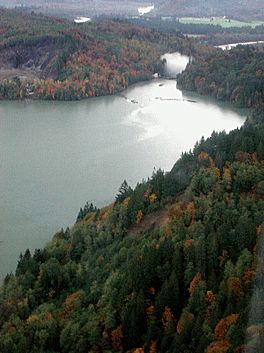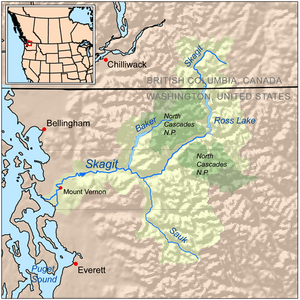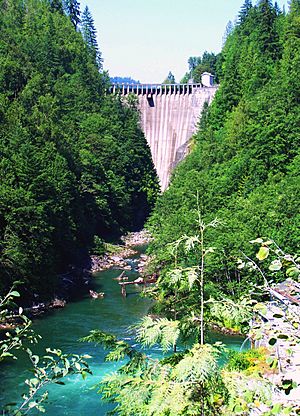Lake Shannon facts for kids
Quick facts for kids Lake Shannon |
|
|---|---|

Lake Shannon looking downstream during the floods of 2003, with the Lower Baker Dam in the distance
|
|
| Location | North of Concrete, Skagit County, Washington, US |
| Coordinates | 48°32′51″N 121°44′28″W / 48.54750°N 121.74111°W |
| Type | Reservoir |
| Primary inflows | Baker River, Thunder Creek, Sulphur Creek, other small tributaries |
| Primary outflows | Baker River |
| Catchment area | 270 square miles (700 km2) |
| Basin countries | United States |
| Built | April 1, 1924 |
| First flooded | September 1, 1925 |
| Max. length | 7.5 miles (12.1 km) |
| Max. width | 1 mile (1.6 km) |
| Surface area | 2,190 acres (8.9 km2) |
| Average depth | 70 feet (21 m) |
| Max. depth | 280 feet (85 m) |
| Water volume | 161,470 acre-feet (199,170,000 m3) |
| Surface elevation | 436 feet (133 m) at full pool |
| Frozen | In winter |
| Islands | 1, unnamed, near north end |
| Settlements | Concrete |
Lake Shannon is a long, narrow lake in Skagit County, Washington, USA. It is a reservoir, which means it's an artificial lake created by a dam. The lake was formed in the 1920s when the Lower Baker Dam was built.
Lake Shannon is about 7.5 miles (12 km) long and 0.6 miles (1 km) wide when it's full. It's located near the North Cascades National Park. This lake is an important part of the Puget Sound Energy's power project on the Baker River.
Before Lake Shannon was created, the area was used for trapping animals, logging trees, and making concrete. Building the Lower Baker Dam stopped salmon from swimming up the Baker River. So, a special system was built in the 1950s to help fish move past the dam. Today, the lake is home to many kokanee salmon. People enjoy Fishing, boating, and water skiing on Lake Shannon.
Contents
About Lake Shannon
The Baker River flows south for about 30 miles (50 km) until it meets the Skagit River. Just a short distance from its mouth, the Lower Baker Dam was built. This dam is 285-foot-high (87 m) and created Lake Shannon, which covers about 2,190-acre (8.9 km2).
The lake sits in a valley of the Baker River. On the west side, there's a flat area called a river terrace. The east side is smoother. Tall, forested mountains surround the lake, but they are not as steep as the mountains further up the river.
The widest parts of Lake Shannon are closer to the dam. In the middle, the lake becomes very narrow. The upper part of the lake is also very thin and reaches into the Mount Baker-Snoqualmie National Forest. Just above Lake Shannon, another dam, the Upper Baker Dam, forms a larger lake called Baker Lake.
Two big mountains are nearby: Mount Baker is 10,781 feet (3,286 m) tall and is a few miles northwest. Mount Shuksan is 9,127 feet (2,782 m) tall and is to the north-northeast. Besides the Baker River, other streams flow into Lake Shannon. These include Thunder Creek and Sulphur Creek.
The Baker River Road runs along the east side of Lake Shannon. The North Cascades Highway crosses the Baker River just below the lake. Most of the water in Lake Shannon comes from the Upper Baker Dam. But it also gets water from a 82 square miles (210 km2) area around it.
Dams and Power Generation
The Lower Baker Dam was built in 1925. It was the first of two dams made to create electricity for the Baker River Hydroelectric Project. This project is owned by Puget Sound Energy. The dam is 285 feet (87 m) high and 550 feet (170 m) long. It has about 24 openings at the top for water to spill over.
Water from Lake Shannon flows through a large pipe called a penstock. This pipe carries water to a powerhouse on the side of the river. Inside the powerhouse, the flowing water spins machines called turbines. These turbines generate 79 megawatts of electricity. After making power, the water flows back into the river below the dam. This means the river section right below the dam is often almost dry.
When the lake is full, its water level is 438 feet (134 m). To generate power, the lake needs to be at least 370 feet (110 m) deep. The lake can hold a lot of water, about 161,470 acre-feet (199,170,000 m3).
Below the Lower Baker Dam, there's a special "fish passage structure." This concrete wall helps fish move. It's part of a fish elevator and flume system. This system lifts fish, like salmon, upstream to Baker Lake. Once in Baker Lake, the fish can swim to their spawning grounds to lay eggs.
History of the Lake and Dam
Before the Baker River project, Lake Shannon didn't exist. Baker Lake was also smaller and formed by a natural pile of rocks left by a glacier. Each spring, many anadromous fish (fish that live in the ocean but breed in fresh water) would swim up the Baker River. Sometimes, more than 20,000 salmon would return. In the 1800s, the area was mainly used for cutting down trees. There were also large amounts of lime rock near the Baker River's mouth, which led to a cement plant being built in what is now Concrete.

Construction of the Lower Baker Dam began on April 1, 1924. At first, 150 workers were on the job. By the next year, 900 people were working on it. In early 1925, the dam was completed to a height of 230 feet (70 m). The lake first filled up in November of that year. Later, the dam was made even taller, reaching its current height. The first electricity from the dam was generated on November 19, 1925.
Building the dam and creating the lake greatly affected the salmon in the Baker River. The dam left only 1 mile (1.6 km) of the river open for salmon to return. Before the dam, over 20,000 salmon would come back to lay eggs. After the dam, this number often dropped below 3,000. In 1985, a record low of only 99 fish returned. To help the salmon, a system was built to catch returning fish and move them into Lake Shannon. In 1959, this system was improved to place the fish directly into Baker Lake instead.
On July 9, 1959, the Upper Baker Dam was finished. This meant the amount of water flowing into Lake Shannon could be controlled for the first time. In 1965, a big landslide damaged the Lower Baker powerhouse. New machines were built, and the water pipe (penstock) was made longer to reach the new powerhouse. In 1991, a project called the Koma Kulshan Project redirected some water from streams flowing into Lake Shannon to Baker Lake.
Wildlife and Nature
One of the most common fish in Lake Shannon is the kokanee salmon. These kokanee are a type of salmon that live their whole lives in freshwater. They are thought to be the offspring of sockeye salmon and coho salmon that spawned in the lake's smaller streams, like Sulphur Creek and Thunder Creek. Some young salmon escaped the pipes that carry them to the lower river, and they stayed in the lake, creating the kokanee population.
There are also bull trout living in Lake Shannon. The area around Lake Shannon is mostly covered with Douglas fir trees and other coniferous (cone-bearing) and deciduous (leaf-shedding) trees.
Fun Activities at Lake Shannon
Lake Shannon is about 1 mile (1.6 km) north of Concrete and 35 miles (56 km) east of Mount Vernon. You can usually reach the lake by following the Baker River Road. Parts of Lake Shannon are inside the Mount Baker-Snoqualmie National Forest.
You can go swimming, boating, and water-skiing on the lake. There are also many kokanee salmon for fishing. However, to get to the boat launch area, you need to go through private land. The lake is usually open for fishing from the last Saturday of April until October 31st each year. There are plans to make the hiking trails around the two lakes longer by 8 miles (13 km) and improve other things in the area.




